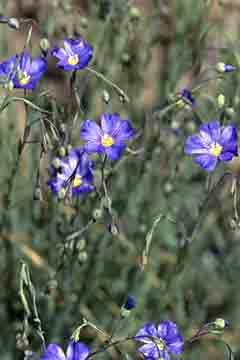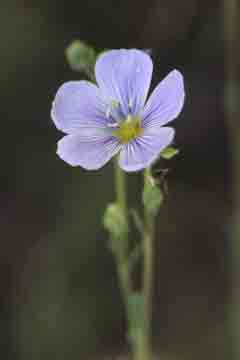
Cultivated flax, Linum usitatissimum L. (left) is planted as an ornamental, both in gardens, and as a roadside plant where it often forms crowded masses of bright blue flowers. These are annual plants—unlike the perennial wild blue flax—that reseed themselves and may persist for years in the same location. There are other differences between the wild and cultivated plants. The wild flax has slightly wider leaves and our alpine variety (right) is lighter in color. Also, the cultivated flax is dimorphic in that some flowers have anthers that are longer than the styles, and in other flowers the opposite is true. The species name, usitatissimum means “most useful.”
Wild blue flax, Linum lewisii Pursh var. alpicola Jepson (right). The wild blue flax (Lewis’s blue flax, prairie flax), Linum lewisii, is widely distributed west of the Mississippi River, north to Alaska. Two varieties are recognized. The variety shown here occurs in circumscribed islands in the mountains of central Idaho as well as in Nevada and California. The plants grow on rocky, south-facing slopes, blooming from June to August, according to elevation—we have seen them in a reduced form well above tree-line. The flowers of this variety are a light grayish-blue, unlike the deep blue of plants (var. lewisii) that grow at lower elevations. The species name honors Meriwether Lewis who collected the previously unknown wild blue flax on Montana’s Sun River during the expedition’s return journey (July 9, 1806). It is one of four plants that bear the explorer’s name.* A yellow-petaled species, the Uinta mountain (or sandplain) flax, Linum kingii S. Watson, occurs in south-eastern Idaho, and elsewhere in the Great Basin drainage, although we have not encountered it.
* The other three are: bitterroot, Lewisia rediviva; mock-orange (syringa), Philadelphus lewisii; and Lewis’s monkeyflower, Mimulus lewisii; all are shown on this web site.
